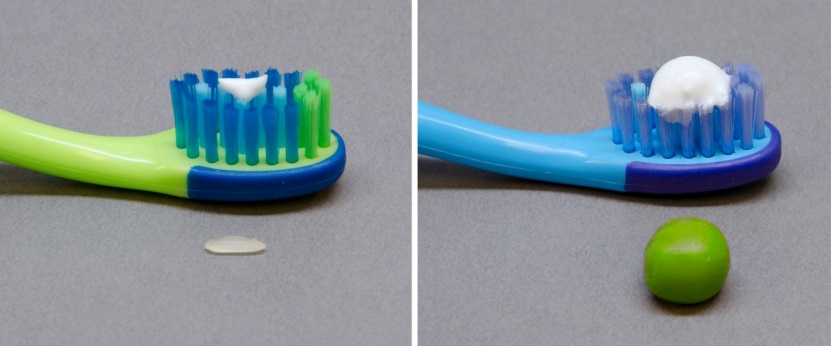Introduction
The National Oral Health Survey of Preschool Children 2015 showed 7 in 10 children aged 5 years old in Malaysia has carious tooth.
A combination of dental care by dental professionals and self care are important to ensure the child’s oral health is maintained. Professional care includes having regular dental check ups and clinical preventive treatment such as fluoride varnish application. Parents can also practice self care at home by brushing the child’s teeth and instilling good dietary habits.
The right selection of toothpaste plays a role to good oral healthcare. This article serves to provide some information on children’s toothpaste.
-
Use toothpaste which contains Fluoride
Fluoride is safe and necessary to keep the teeth strong, when taken at appropriate levels. Fluoride is a mineral that occurs naturally in many foods and water. It can be found in tea and salt but people do not get toxicity by consuming these as fluoride is safe and is not harmful at low or optimum levels (dose-response).
Many parents are concern that their child might swallow the fluoridated toothpaste and develop toxicity. However, this might only happen if the child has accidently swallowed the whole toothpaste at once. Brushing teeth with fluoride toothpaste will not cause toxicity but parents should however supervise their child’s brushing.
The use of Fluoride as a preventive measure for dental caries has contributed to the overall reduction in the prevalence of dental caries worldwide (Brambilla 2001; Ellwood and Fejerskov, 2003).
Fluoride can :
- Enhance remineralization of early enamel lesion,
- Incorporate within enamel making it more acid resistant, and
- Inhibit bacterial activity in the plaque to produce acid.
-
The right dosage of fluoride in toothpaste
A review by Wash et al confirms the benefits of using fluoride toothpaste in preventing caries in children compared to placebo, at fluoride concentration of 1000 ppm.
The caries preventive effects of fluoride toothpastes of different concentrations increase with higher fluoride concentrations. The fluoride levels to use for children below 6 years should be balanced with the risk of fluorosis.
-
The amount of toothpaste recommended
The American Dental Association (ADA) recommends the use of a smear (left image) of fluoride toothpaste in children as soon as the tooth erupts and then a pea-sized dollop (right image) for ages 3 to 6.

The frequency of brushing
Parents can clean the child’s gums with an infant gum massager, or use a clean damp gauze or wash cloth before the child gets their first tooth.
Once the child’s tooth has erupted, parents can brush them at least twice a day using a soft bristled toothbrush.
-
Kid-friendly Flavors
Tooth-brushing should be a pleasant experience for children. The use of correct toothpaste plays an important role in encouraging children to brush and take care of their teeth. The toothpastes sold in the market have mostly been added with fruity flavors. Its use is recommended only at the earlier age when introducing toothpaste to the child.
Parents are advised to read the label of the flavored toothpaste as it usually contains lower dosage of fluoride (500 ppm) than the recommended 1000 ppm. Apart from this, the child also tends to swallow the toothpaste due to its flavor. Thus, parents should be more cautious when using this flavored toothpaste.
-
Read the toothpaste’s labels
According to Stovell et al (2013), an ideal children’s toothpaste formulation should aim to maximise fluoride availability, minimise abrasivity and use flavour and surfactant at levels and types that will minimise interference with fluoride delivery as well as to deliver a pleasant brushing experience. Reading toothpaste labels will help parents to choose the right toothpaste for their child. The ingredients of the toothpaste can be found at every packaging and each has its own purpose.
- Mild abrasives to remove debris and residual surface stains. Examples of abrasives include calcium carbonate, dehydrated silica gels, hydrated aluminium oxides, magnesium carbonate, phosphate salts and silicates.
- Fluoride to strengthen tooth enamel and remineralize enamel in the early stages of tooth decay.
- Humectants to prevent loss of water in the toothpaste. Examples include glycerol, propylene, glycol and sorbitol.
- Flavouring agents, such as saccharin and other sweeteners to improve taste. It is recommended to use toothpaste that contains no sugar or other sweeteners that could promote tooth decay.
- Thickening agents or binders to stabilize the toothpaste formula. These include mineral colloids, natural gums, seaweed colloids or synthetic cellulose.
- Detergents to create foaming action. They include sodium lauryl sulfate, sodium N-Lauryl sarcosinate.
Conclusion
The selection of children’s toothpaste should follow the recommendations of the Ministry of Health for optimum benefits to the child’s oral health, with emphasis on the amount of usage. Understanding the label content of the toothpaste can enable parents to make the right selection for their child.
References
- ADA Science Institute, Center for Scientific Information. Toothpaste and Children. Topic last updated: November 29, 2017. Available at https://www.ada.org/en/member-center/oral-health-topics/toothpastes.
- Brambilla E (2001). Fluoride – is it capable of fighting old and new diseases? An overview of existing fluoride compounds and their clinical applications. Caries Res, 35 (Suppl 1) : 6-9.
- Ellwood R and Fejerskov O (2003). Clinical use of fluoride. In: Fejerskov O and Kidd EAM (eds) Dental Caries- The Disease and Its Clinical Management. London: Blackwell Munksgaard, pp 189-222.
- Oral Health Division, Ministry of Health Malaysia. National Oral Health Survey for Preschool Children 2015 (NOHPS 2015).
- Stovell, A. G., Newton, B. M., & Lynch, R. J. (2013). Important considerations in the development of toothpaste formulations for children. International Dental Journal, 63(s2), 57-63.
- Wash T, Worthington HV, Glenny AM, Appelbe P, Marinho VCC, Shi X. Fluoride toothpastes of different concentrations for preventing dental caries in children and adolescents. Cochrane Database of Systematic Reviews 2010, Issue 1. Art. No.: CD007868. DOI: 10.1002/14651858.CD007868.pub2.
| Last Reviewed | : | 12 June 2018 |
| Writer | : | Dr. Nurul Ashikin bt. Husin |
| Accreditor | : | Dr. Cheng Lai Choo |







